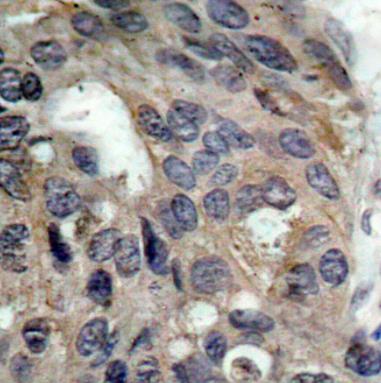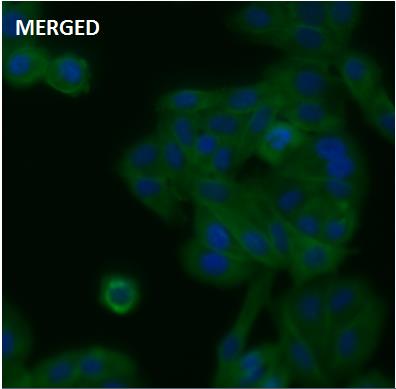Product Detail
Product NameSrc (Phospho-Tyr530) Rabbit mAb
Clone No.S03-8H8
Host SpeciesRecombinant Rabbit
ClonalityMonoclonal
IsotypeIgG
PurificationAffinity Purified
ApplicationsWB, ICC/IF, IHC
Species ReactivityHuman,Mouse,Rat
Immunogen DescA synthetic phosphopeptide corresponding to residues surrounding Tyr529 of human Src
ConjugateUnconjugated
Other NamesASV; SRC1; THC6; c-SRC; p60-Src
Accession NoSwiss-Prot:P12931
GeneID:6714
Uniprot
P12931
Gene ID
6714
Calculated MWPredicted band size: 60 kDa
Sdspage MWObserved band size: 60kDa
Concentration0.3 mg/ml
Formulation50mM Tris-Glycine(pH 7.4), 0.15M NaCl, 40% Glycerol, 0.01% Sodium azide and 0.05% BSA
StorageStore at 4˚C short term. Aliquot and store at -20˚C long term. Avoid freeze/thaw cycles.
Application Details
WB: 1:500-1:2000
ICC/IF: 1:50-1:200
IHC: 1:50-1:200
All lanes : Src (Phospho-Tyr530) Rabbit mAb at 1/1k dilutionLane 1 : Mouse Brain lysatesLane 2 : Rat Brain lysatesLane 3 : HT29 whole cell lysatesLane 4 : HT29 treated with 200nM PMA for 30 min whole cell lysatesLysates/proteins at 20 µg per lane.SecondaryAll lanes : Goat Anti-Rabbit IgG H&L (HRP) at 1/20000 dilutionPredicted band size: 60 kDa Observed band size: 60kDaExposure time: 8 seconds
Formalin-fixed, paraffin-embedded human breast carcinoma tissue stained for Src (Phospho-Tyr530) using 52704 at 1/100 dilution in immunohistochemical analysis.
Immunocytochemistry/ Immunofluorescence Src (Phospho-Tyr530) antibody (52704)
ICC/IF staining of Src (Phospho-Tyr530) in Hela cells. Cells were fixed with 4% Paraformaldehyde permeabilized with 0.1% Triton X-100.
Samples were incubated with 52704 at a working dilution of 1/100. The secondary antibody was Alexa Fluor® 488 goat anti rabbit, used at a dilution of 1/500.
Nuclei were counterstained with DAPI.
Non-receptor protein tyrosine kinase which is activated following engagement of many different classes of cellular receptors including immune response receptors, integrins and other adhesion receptors, receptor protein tyrosine kinases, G protein-coupled receptors as well as cytokine receptors. Participates in signaling pathways that control a diverse spectrum of biological activities including gene transcription, immune response, cell adhesion, cell cycle progression, apoptosis, migration, and transformation. Due to functional redundancy between members of the SRC kinase family, identification of the specific role of each SRC kinase is very difficult. SRC appears to be one of the primary kinases activated following engagement of receptors and plays a role in the activation of other protein tyrosine kinase (PTK) families. Receptor clustering or dimerization leads to recruitment of SRC to the receptor complexes where it phosphorylates the tyrosine residues within the receptor cytoplasmic domains. Plays an important role in the regulation of cytoskeletal organization through phosphorylation of specific substrates such as AFAP1. Phosphorylation of AFAP1 allows the SRC SH2 domain to bind AFAP1 and to localize to actin filaments. Cytoskeletal reorganization is also controlled through the phosphorylation of cortactin (CTTN) (Probable). When cells adhere via focal adhesions to the extracellular matrix, signals are transmitted by integrins into the cell resulting in tyrosine phosphorylation of a number of focal adhesion proteins, including PTK2/FAK1 and paxillin (PXN) (PubMed:21411625).
In addition to phosphorylating focal adhesion proteins, SRC is also active at the sites of cell-cell contact adherens junctions and phosphorylates substrates such as beta-catenin (CTNNB1), delta-catenin (CTNND1), and plakoglobin (JUP). Another type of cell-cell junction, the gap junction, is also a target for SRC, which phosphorylates connexin-43 (GJA1). SRC is implicated in regulation of pre-mRNA-processing and phosphorylates RNA-binding proteins such as KHDRBS1 (Probable). Also plays a role in PDGF-mediated tyrosine phosphorylation of both STAT1 and STAT3, leading to increased DNA binding activity of these transcription factors (By similarity).
Involved in the RAS pathway through phosphorylation of RASA1 and RASGRF1 (PubMed:11389730).
If you have published an article using product 52704, please notify us so that we can cite your literature.





 Yes
Yes



